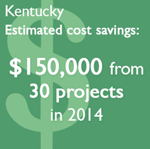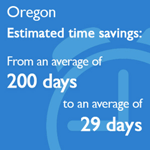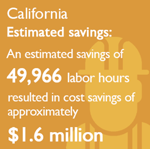
Data-driven Success Stories Highlight Value of Programmatic Agreements
Programmatic agreements (PAs) are featured as part of the Every Day Counts initiative, which aims to advance a culture of innovation among the highway community with an emphasis on environmental sustainability and more efficient project delivery processes. PAs apply a systematic, program-level approach to preservation and conservation of environmental and historic assets, establishing streamlined processes for consultation, review, and compliance with one or more related Federal laws. PAs are usually best suited for routine projects as these projects can be easily streamlined and simplified, allowing agencies to shift their focus to more complex projects. However, PAs may also be useful for projects that are complex and broad in scope, providing an opportunity to generate wide-ranging benefits for stakeholders and resources.
The Federal Highway Administration (FHWA) and transportation practitioners have long recognized PAs' ability to cut project costs and timelines, but they previously have lacked quantitative evidence of these savings. To fill this void, FHWA collected and analyzed available data from successful PAs in place around the country and compiled findings into a report titled Benefits and Costs of Programmatic Agreements. Now, anecdotal success stories are paired with data, working together to reinforce and promote the effectiveness of PAs.
Methodology: Report Origins and Dealing with Data Discrepancies
FHWA, in conjunction with the John A. Volpe National Transportation Systems Center, collaborated with seven States over the course of almost a year to create the report and its cost-benefit analysis. The report includes case studies on three types of PAs: Endangered Species Act (ESA) Section 7 PAs, National Historic Preservation Act (NHPA) Section 106 PAs, and National Environmental Policy Act (NEPA)/Clean Water Act (CWA) Section 404 merger processes. For each case study, FHWA conducted interviews with State and Federal stakeholders and outlined baseline comparisons for quantitative impacts where data was available.
Most of the PAs studied had gone through multiple iterations and been in place for over a decade, so some data elements were not available. For example, the way that metrics were measured changed over time, making standardization and comparisons difficult. Because of this challenge, not all information is comparable across case studies. As summarized in the textbox, though, data can play a significant role in assessing and enhancing PA effectiveness. By tracking projects from the start, States can determine which parts of the process will benefit from PAs. Measurements can also be a valuable tool in defining cost-benefit ratios.
Despite some challenges in data collection, the analysis showed positive results in utilizing PAs. Overall, PAs shortened task and project timelines by over 50 percent, increased levels of predictability for stakeholders, and improved broad decisionmaking and project outcomes.

Kentucky's ESA Section 7 PA streamlines projects that affect the habitats of endangered species, such as the Indiana bat. (Courtesy of KYTC)
Case Study Results Emphasize Efficiency, Predictability
The following case studies show the approaches studied and results highlighted in FHWA's Benefits and Costs of Programmatic Agreements.
Measuring Success
In order to best gauge success, it is advantageous for States beginning to implement PAs to identify and monitor key metrics and related data points. Here are some points to consider tracking:
Budgeting: Reduction in project costs to complete each project, including labor hours and costs broken down by task.
To evaluate their ESA Section 7 PA, Kentucky tracked funds paid into the IBCF for projects completed in the last year. Based on the estimated average amount paid in the absence of the PA, the average per project savings was determined to be at least $5,000.
Mitigation/Conservation: Improved project outcomes relative to a baseline (for example, reduced environmental impact, improved habitats, preserved historic/cultural area) and improved public opinion.
California's NHPA Section 106 PA streamlined internal processes, increasing the ability to respond more quickly in times of emergency or natural disaster.
Planning: Staff labor hours, reduction in project timeline, beginning and completion dates for all steps, and length of time required to complete each step.
Washington's ESA Section 7 PA measured impact by looking at the number of formal and informal consultations for State projects, the average number of calendar days each consultation took to complete, and the average labor hours and cost for each type of consultation. While formal consultations are mandatory for projects that may adversely affect listed species or critical habitats, an informal consultation is an optional process to help an agency determine whether formal consultation is needed.
Endangered Species Act Section 7
ESA protects and preserves threatened and endangered species and their habitats. Section 7 of the ESA mandates that federally funded transportation projects comply with two requirements. The first is that projects must not jeopardize the continued existence of a listed threatened or endangered species or result in adverse modifications to critical habitat. The second requirement is that FHWA and the State Department of Transportation (DOT) involved in the project must consult with the U.S. Fish and Wildlife Service (FWS) and the National Oceanic and Atmospheric Administration (NOAA) Fisheries and submit biological assessments (BAs) to them if marine and anadromous species might be affected. Through improved communication and collaboration, ESA Section 7 PAs accelerate the process of working with multiple stakeholders and reduce labor hours associated with meeting ESA requirements.

Kentucky: Almost all transportation projects developed and implemented by the Kentucky Transportation Cabinet (KYTC) face a possibility of impacting the habitat of the endangered Indiana bat (Myotis soldalis). Both the previous 2006 and current 2011 ESA Section 7 PAs, signed by KYTC, FHWA, and FWS, required KYTC to pay into the Indiana Bat Conservation Fund (IBCF) to offset projects that impact Indiana bat habitat. Had a PA not been in place, KYTC estimates that the average cost per formal consultation, a process required for projects that may adversely affect listed species or critical habitats, would have been approximately $15,000 for the last year, due to the volume of BAs required. KYTC, FHWA, and FWS developed the new agreement over a year's time with an estimated labor investment of $43,000. However, KYTC estimates that the PA will save $5,000 per project, translating to a total savings of $150,000 from 30 projects in 2014 alone.

Oregon: The Oregon Department of Transportation (ODOT), NOAA Fisheries, and FHWA developed an ESA Section 7 PA to cover projects that result in consultations on 17 listed species and 16 critical habitats. The PA covers approximately 95 percent of ODOT projects. Prior to the PA, formal consultations for most individual ODOT projects involved costly, lengthy, and complex BAs. Furthermore, biological opinions (documents that are the product of formal consultation) can face regulatory uncertainty, resulting in project delays or constructability issues.
ODOT implemented the PA in January 2013 with an estimated labor investment of approximately $350,000. However, the PA reduced NOAA Fisheries liaison staffing by streamlining the consultation process, cut average BA preparation costs, and decreased project review time from an average of 200 days to an average of 29 days. This resulted in cost savings of over $1.2 million over 18 months. The PA has been in use for 18 months, with 93 projects processed or underway.
The National Historic Preservation Act Section 106
The NHPA Section 106 PA case study features California and Ohio. In 1966, NHPA established Federal policy to consider historic assets in project planning and management. Section 106 of the NHPA, requires Federal agencies to take into account the effects of their actions on properties which are listed or eligible for listing in the National Register of Historic Places. This process requires working with a variety of stakeholders, including State Historic Preservation Offices (SHPOs), Tribal Historic Preservation Offices, the Advisory Council on Historic Preservation, and State DOTs for FHWA-funded projects. Section 106 PAs streamline this coordination by delegating responsibilities with the Section 106 process, defining actions not subject to further review, and establishing agreed upon measures to mitigate impacts to historic resources.

California: California's Section 106 PA, implemented in 2004, streamlines the process of environmental analysis in developing federal-aid highway projects that have the potential to impact historic and archeological resources except on Tribal lands. Prior to the PA, the California SHPO reviewed projects to consider the degree to which they would impact historic properties. Under the PA, select California Department of Transportation (Caltrans) staff members are certified to determine project impacts without SHPO involvement. While some projects with significant impacts still require SHPO review, the PA allows Caltrans to screen out less complex projects that do not require SHPO coordination. In a two-year period, Caltrans screened out 2,341 of the 2,539 projects, leaving only 195 projects that required SHPO involvement in the Section 106 review. This resulted in an average savings of 45.5 hours per project, reducing review time from an average of 120 days to an average of 30-60 days. These reduced labor hours translated to cost savings of $1.6 million.
National Environmental Policy Act/Clean Water Act Merger Process
The objective of the NEPA/CWA Section 404 merger, which aligns the requirements of both acts to avoid any unnecessary delays, is to improve the efficiency of the FHWA NEPA process by using early and active interagency coordination to streamline projects involving the placement of fill material into U.S. waters. For these projects, the U.S. Army Corps of Engineers (USACE) is responsible for issuing permits and assessing whether the project is following the requirements of Section 404 of the CWA. In addition to USACE, FWS, NOAA Fisheries, and the Environmental Protection Agency may also be involved in Section 404 permitting.
The NEPA/CWA Section 404 PA case study highlights merger processes from Illinois and North Carolina. These States use Section 404 merger processes, in the form of formal agreements, to streamline communication and consultation between agencies, USACE, and other stakeholders and avoid expenses likely to exceed the estimated implementation and refinement costs. Establishing early buy-in on key points (the PA's purpose and need, preferred alternatives, etc.) and repeated meetings lead to avoided costs and complications when attempting to receive an individual CWA Section 404 permit; the merger process can help agencies and other stakeholders make strategic decisions early in the project development process, which will set them up for successful permit issuance.
It was particularly difficult to establish either a “before and after” comparison or a concurrent baseline for the two merger processes highlighted in FHWA's report. As a result, the baseline itself was primarily comprised of qualitative or anecdotal evidence. Illinois and North Carolina's Section 404 PAs resulted in time savings through early engagement between resource and regulatory agencies and improved project coordination, increased level of certainty regarding project timelines, improved public opinion, and improved project decisions, leading to enhanced project outcomes.
Strategic Investments Result in Valuable Impacts
The PA process typically requires significant upfront and ongoing investment and PAs must be updated and revised over time based on changing needs and requirements. However, FHWA's Benefits and Costs of Programmatic Agreements report showcases States that are effectively and creatively using PAs to enhance interagency relationships and coordination, proving the value of people over paperwork, as well as saving time and money. To learn more, view FHWA's recent webinar on PAs.
Contact Information
Adam Alexander
Office of Project Development and Environmental Review
Federal Highway Administration
(202) 366-1473
Adam.Alexander@dot.gov
Look What's New!
- FHWA updated its Tribal Consultation Guidelines and related frequently asked questions (FAQs). The Tribal Consultation Guidelines are intended to serve as a reference for FHWA staff responsible for carrying out the requirements of Section 106 of the NHPA. Click here to view the updated guidelines and click here to access the revised FAQs.
- FHWA recently released Guidelines for the Visual Impact Assessment of Highway Projects. The guidelines help to incorporate aesthetics into planning processes, providing decisionmakers with the information they need to mitigate adverse impacts effectively while implementing concepts to enhance a community's existing visual quality. To read the guidelines, click here.
- FHWA's Webinar Series: Building a Climate Resilient Transportation System has numerous upcoming webinars in April and May. These webinars will focus on FHWA climate change resilience pilot projects and international climate resilience practices. Click here for more information on the series and to register for the webinars.
Successes in Stewardship is a Federal Highway Administration newsletter highlighting current environmental streamlining and stewardship practices from around the country. Click here to subscribe, or call (617) 494-3539 for more information.

